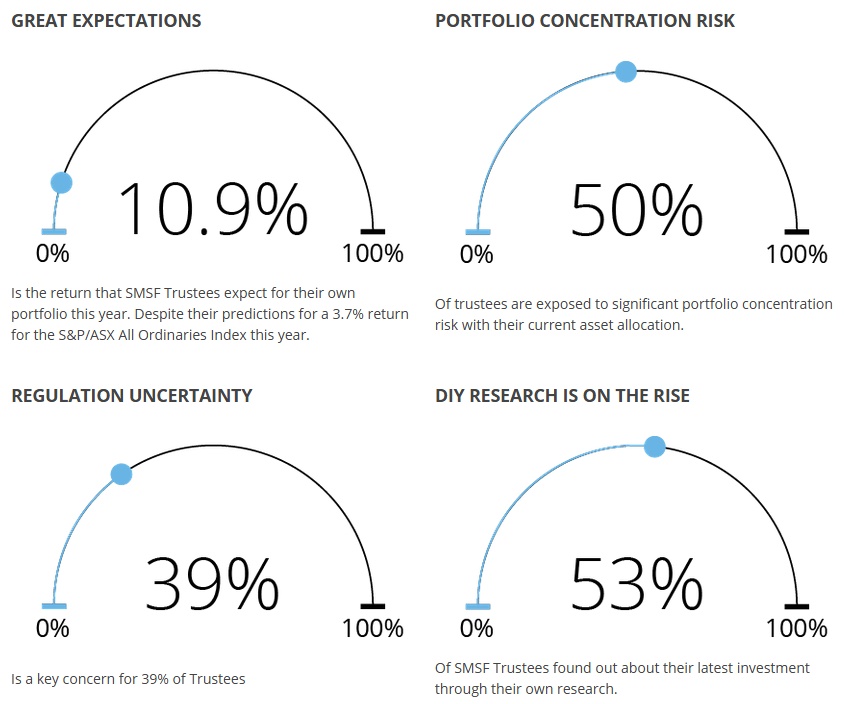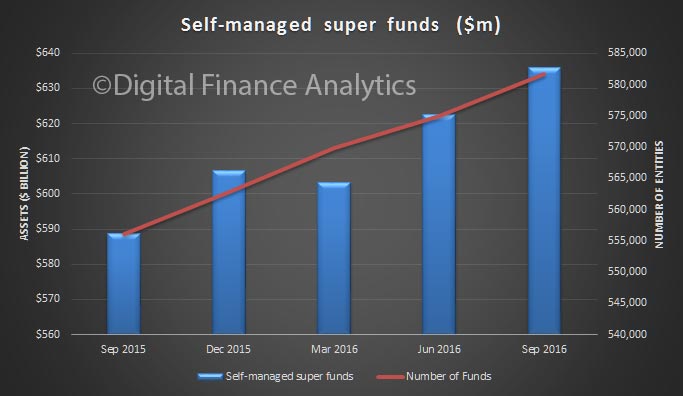The little-known superannuation tax lurk that has pushed $20 billion into the property market in just under five years is under attack, with Labor promising to ban private superannuation funds from borrowing and the Coalition foreshadowing new restrictions.
As The New Daily recently reported, self-managed superannuation fund borrowing arrangements have grown almost tenfold, from $2.5 billion in June 2012 to $24.3 billion last December. The lion’s share of that is going into commercial and, increasingly, residential property.
That has been a concern for regulators, with the Murray inquiry into the financial system in 2014 recommending SMSF borrowing be banned, warning “further growth in superannuation funds’ direct borrowing would, over time, increase risk in the financial system”. The Reserve Bank concurred.
Opposition Leader Bill Shorten on Friday announced he would ban SMSF borrowing if Labor comes to power as part of a bid to “cool an overheated housing market partly driven by wealthy self-managed super funds. Allowing this [SMSF borrowing] to continue would increase risk in the superannuation system and crowd out more first home owners”.
Stephen Anthony, chief economist at Industry Super Australia, said a ban would be “an obvious structural reform that would have benefits through the economy and to the budget”.
The Coalition has been silent on the issue in recent times, but Financial Services Minister Kelly O’Dwyer responded on Friday to questions from The New Daily foreshadowing moves to make the process less attractive.
“The Government will be progressing a package of minor and technical amendments including a proposed limited recourse borrowing arrangement (LRBA) integrity measure to address a potential concern that has been raised during the implementation of the superannuation taxation reform package.”
While the meaning of that is not altogether clear to the uninitiated, tax expert and principal with Arnold Bloch Leibler, Mark Leibler, told The New Daily it foreshadows action to prevent SMSF owners using borrowings to circumvent a $1.6 million cap on tax-free super retirement pensions due to start on July 1.
“It sounds to me like what they’re going to do is prevent people using borrowings to get around the $1.6 million cap,” Mr Leibler said.
Using an example of an SMSF owning a $2 million property with borrowings of $400,000, Mr Leibler said that if borrowings were not factored into the cap, owners would effectively get the benefit of a $2 million investment while staying within the $1.6 million cap.
Stephen Anthony described the Coalition move as “interesting. But if their intention is to reduce the incentive to borrow in SMSFs you’d have to ask why they don’t just rule it out entirely.”
While the foreshadowed move might reduce SMSF borrowing, it still leaves plenty of space for funds under the cap limit to borrow, Mr Anthony said.
Peter Strong, CEO of the Council of Small Business Australia, said Labor’s SMSF plans could negatively affect small businesspeople trying to buy their business premises.
“It’s good business for businesses to invest in their business. For most businesspeople their business is their super plan, so there could be unintended consequences in this. They need to be looked at,” Mr Strong said.
It also appears that Treasurer Scott Morrison has lost the cabinet battle to allow first homebuyers to dip into super to fund a housing deposit.
On Friday, Finance Minister Mathias Cormann, who is part of the government’s budget “razor gang”, told Sky News: “That’s not something we think would address the problem.”
Prime Minister Malcolm Turnbull has also come down against the move, saying, “The purpose for superannuation is to provide for retirement, that’s the objective.” The Treasurer had previously supported the idea.
Tag: SMSF
A disconnect between the growth objectives and asset allocation of SMSF trustees
Self-managed superannuation fund (SMSF) trustees have high growth expectations for the next 12 months yet as many as 55 per cent have moved to a more defensive asset allocation amid continuing market volatility, according to AMP Capital.
Statistics from AMP Capital’s latest Black Sky Report show that while SMSF trustees expect a 10.9 per cent return on their portfolio this year (6 per cent capital and 4.9 per cent income), only 18 per cent of trustees have made changes to position their portfolio for growth. This is, however, an increase of five percentage points from 2015.
Further to this, nearly half of SMSF trustees surveyed for the report say their aim is to have a fully diversified portfolio yet more than 50 per cent of their portfolio is invested in just one investment type outside of managed funds.
AMP Capital Head of Self-Directed Wealth and SMSF Tim Keegan said: “If trustees continue to be exposed to significant portfolio concentration risk and remain in more defensive assets without seeking financial advice, they may struggle to achieve their retirement goals.”
AMP Capital’s Black Sky Report is developed each year to provide a snapshot of trustee investment trends. It also helps to arm financial advisers with insight and knowledge of where SMSF trustees are looking for specific advice.
The 2017 report has identified the biggest investment challenges for SMSF trustees as market volatility (according to 18 per cent of trustees surveyed), investment selection (11 per cent) and regulatory changes (10 per cent).
Mr Keegan said: “It’s clear that many SMSF trustees need help especially around portfolio construction and understanding the regulatory changes that are coming into play. With nearly 60 per cent of SMSF trustees remaining open to using the expertise of a financial adviser, it’s clear this is a huge opportunity for advisers to tap into.”
The research also revealed that SMSF trustees continue to find managed funds attractive, with 47 per cent each investing approximately $280,000 in them. Thirty per cent of SMSF trustees made their most recent managed fund investment after receiving advice from their financial planner.
Mr Keegan said: “There is an increasing appetite among SMSF trustees to invest in Australian equity funds, both active and passive. Advisers can be proactive in recommending high-quality unlisted managed funds as well as introducing trustees to the increasing range of active exchange traded funds that are now available on the market.”
Active ETFs replicate managed fund strategies but are able to be bought and sold during the trading day like any share on the Australian Securities Exchange. AMP Capital, in alliance with BetaShares, launched three active ETFs during 2016: the AMP Capital Dynamic Markets Fund, the AMP Capital Global Property Securities Fund and the AMP Capital Global Infrastructure Securities Fund.
According to Mr Keegan: “With expectations for growth at an all-time high, regulatory uncertainty at its peak and new products such as active ETFs becoming increasingly popular, there is more need than ever for SMSF investors to turn to financial advisers for support.”
For the third year in a row, AMP Capital has released the Black Sky Report, which uses research and data from leading research house Investment Trends to uncover the latest SMSF investor trends and insights.
The research is based on a quantitative online survey of nearly 800 AMP Capital SMSF investors conducted by Investment Trends. The 2017 Black Sky Report can be downloaded here.
SMSF contribution levels almost triple in response to super changes becoming law
AMP says SMSF trustees looking to make the most of the current rules have significantly increased contributions, according to the latest SuperConcepts SMSF Investment Patterns Survey.
In the December 2016 quarter contribution levels almost tripled, increasing by 181 per cent from $3,040 in the September quarter to $8,550.
The rise in contributions follows the Government’s confirmation that the proposed Super changes will come into effect on July 1 2017.
SuperConcepts Executive Manager Technical & Strategic Solutions Phil La Greca said the findings were not surprising and he anticipated contribution levels would continue to increase during the next two quarters due to the brief window of time to make large non-concessional contributions until 30 June 2017.
“The current non-concessional amounts apply for the remainder of this financial year and investors are taking advantage of the limited time available to them. We expect a continued uplift in the level of nonconcessional contributions in the lead up to July 1,” said Mr La Greca.
The current $180,000 after-tax contributions cap, and the three year $540,000 bring-forward rule remain until 30 June 2017.
Cash levels were also up in Q4 (from 18.1 per cent in the September quarter to 18.4 per cent in the December quarter).
Mr La Greca said it was likely the increased cash levels were related to the higher contribution levels being received.
The trend to invest through the use of exchange-traded funds (ETFs) continued to grow, with ETFs representing four per cent of all assets during the December quarter. ETFs were mostly used in the International Equity Sector, which represented 16.7 per cent of all international equity holdings.
The trend to use a limited recourse borrowing arrangement for property continued. The overall allocation to property loans increased to 81 per cent in the December quarter, up from 75 per cent the previous quarter. Meanwhile the number of financial asset loans decreased from 25 per cent to 19 per cent.
“The ATO’s safe harbour guidelines on related party loans explains the continued drop in the number of financial asset loans,” said Mr La Greca.
The quarterly SuperConcepts SMSF Investment Patterns Survey covers approximately 2,800 funds, a sample of SMSFs administered by Multiport (part of the SuperConcepts group) and the investments they held at 31 December 2016. The assets of the funds surveyed represent approximately $3.2 billion.
About SuperConcepts<
SuperConcepts is a leading provider of self-managed superannuation fund (SMSF) administration, software and education services to SMSF trustees, accountants and financial advisers, servicing more than 55,000 funds. SuperConcepts comprises a number of sub-brands including AMP SMSF, Ascend, Cavendish, Multiport, Justsuper, SuperConcepts, SuperIQ, superMate, yourSMSF and a part ownership of Class Ltd. Find out more at www.superconcepts.com.au.
Do Investment Property Investors Also Use SMSF’s?
We recently featured our analysis of Portfolio Property Investors, using data from our household surveys. We were subsequently asked whether we could cross correlate property investors and SMSF using our survey data. So today we discuss the relationship between property investors and SMSF. We were particularly interest in those who hold investment property OUTSIDE a SMSF.
To do this we ran a primary filter across our data to identity households who where property investors, and then looked at what proportion of these property investors also ran a SMSF. We thought this would be interesting, because both investment mechanisms are tax efficient investment options. Do households use both? If so, which ones?
We found on average, around 13% of property investors also have a self managed super fund (SMSF). Households in the ACT were most likely to be running both systems (17%), followed by NSW (14%) and VIC (12.8%).
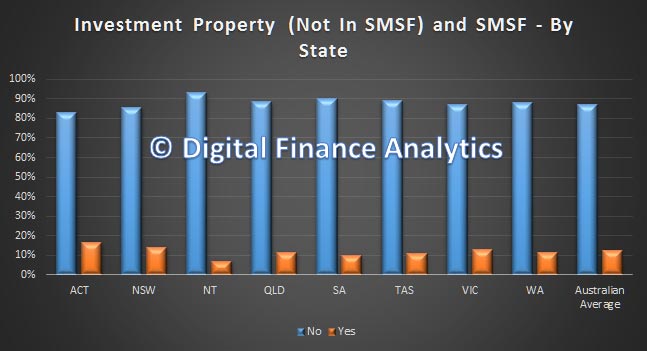 Older households working full time were more likely to have both an SMSF and Investment Property, but we also noted a small number of younger households were also using both tax shelters.
Older households working full time were more likely to have both an SMSF and Investment Property, but we also noted a small number of younger households were also using both tax shelters.
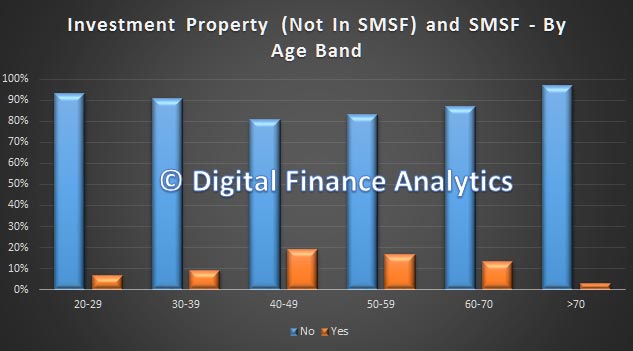 We found a significant correlation between income bands and use of SMSF among investment property holders (this does not tell you about the relative number of households across the income bands, just their relative mix). Up to 30% of higher income banded households have both a SMSF and Investment Property.
We found a significant correlation between income bands and use of SMSF among investment property holders (this does not tell you about the relative number of households across the income bands, just their relative mix). Up to 30% of higher income banded households have both a SMSF and Investment Property.
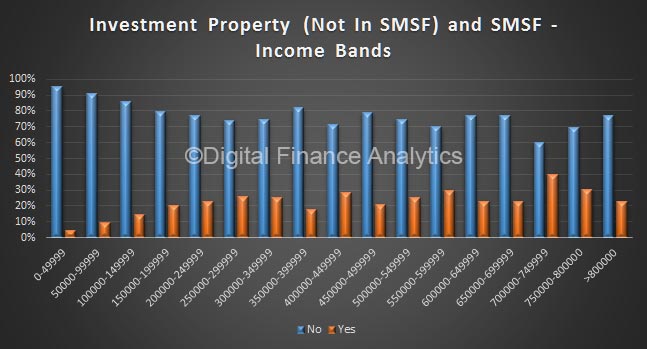 Finally, we look across our master household segments. These segments are the most powerful way to understand how different household groups are behaving. The most affluent groups tend to hold both investment property and SMSF – for example, 30% of the Exclusive Professional segment has both. Less affluent households were much less likely to run a a SMSF.
Finally, we look across our master household segments. These segments are the most powerful way to understand how different household groups are behaving. The most affluent groups tend to hold both investment property and SMSF – for example, 30% of the Exclusive Professional segment has both. Less affluent households were much less likely to run a a SMSF.
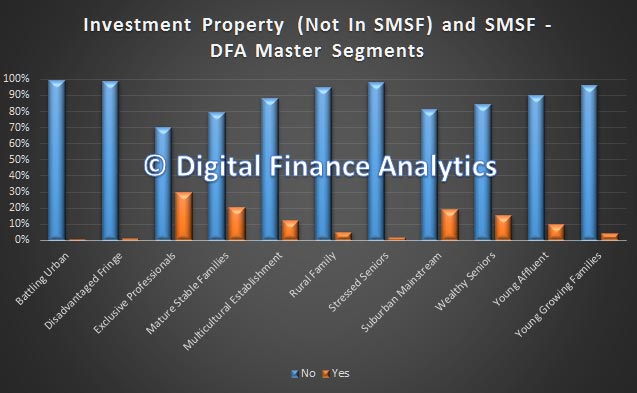 This shows that more affluent households are more able and willing to use both investment tax shelter structures. It also shows that any review of the use of negative gearing, investment properties and the like, needs to be looked at in the context of overall tax planning. Given the new limits on superannuation withdrawals, we expect to see a further rotation towards investment property, which as we already explained has a remarkable array of tax breaks and incentives. We expect the number of Portfolio Property Investors to continue to rise whilst the current generous settings exist.
This shows that more affluent households are more able and willing to use both investment tax shelter structures. It also shows that any review of the use of negative gearing, investment properties and the like, needs to be looked at in the context of overall tax planning. Given the new limits on superannuation withdrawals, we expect to see a further rotation towards investment property, which as we already explained has a remarkable array of tax breaks and incentives. We expect the number of Portfolio Property Investors to continue to rise whilst the current generous settings exist.
Pooled funds beat SMSFs for all but the wealthiest
Most self-managed superannuation fund owners would have made more money investing in industry super funds in the seven years to 2015, according to a new report from the University of Adelaide’s International Centre for Financial Services.
Analysis by The New Daily based on figures produced for the review, which looked at SMSF’s in four bands of value from under $200,000 to over $1 million, found that over the seven years to June 2015 only the largest of SMSFs outperformed pooled funds.
Source:ICFS and Chant West
The top performing SMSF category, those with over $1 million in their fund, averaged 6.8 per cent returns in the seven years to 2015 while the next best performer, industry funds, averaged 6.2 per cent and retail funds
Small SMSFs with less than $200,000 invested on average lost 5.2 per cent a year over the seven years, something their owners would not have been happy with.
The two mid-tier levels of SMSFs both outperformed retail funds, which scored 3.4 per cent but came in behind industry funds, which racked up an annual return average of 6.4 per cent over the seven years. The average for all SMSF’s in the survey was 3.7 per cent over seven years.
Super changes to knock SMSFs from their perch
The performance outcomes reflect the makeup of different fund types. Retail funds with their high equity ratings outperform in years where the share market is strong and underperform, sometimes dramatically, when equities slump.
The hare and the tortoise
Industry funds, with their larger exposure to direct property, infrastructure and private equity, are steadier performers than retail funds, enabling them to perform better over time. Larger SMSF’s were less volatile than retail funds, probably reflecting their higher propensity to invest in property.
Steady progress wins out. Photo: Getty
The costs of running SMSF’s hit hard at the performance of smaller funds. Expenses for the smallest funds were as high as 6.8 per cent of fund value while for the largest they were as little as 0.6 per cent and averaged 0.9 per cent. These expenses include accountancy, legal costs and investment advice.
Figures for pooled funds provided by SuperRatings show that Fee Quartiles for pooled funds range from 0.76 per cent to 1.26 per cent for funds over $500,000 and 0.9 per cent and 1.5 per cent for $50,000 funds. Industry funds tend to be at the lower of these ranges with retail funds at the upper end although for-profit My Super funds are also at the lower range.
You need big bucks for an SMSF
David Simon, principal of advisory house Integral Private Wealth, told The New Daily that while it was arguable that SMSF’s could be viable with balances of $250,000 “they’d generally need to be between $400,000 and $500,000 to be properly diversified and make use of the extra investment choice that SMSFs offer.”
Industry and retail funds increasingly offer members the capacity to invest in individual stocks, term deposits and sector specific funds so “the attractiveness bar that SMSF’s have to get over is higher than before,” Mr Simon said.
Professor Ralf Zurbrugg of the University of Adelaide, an author of the report, said while benefits of size for SMSFs faded quickly once balances reached $500,000. “Above that level performance [resulting from lower running costs] saw only marginal improvement,” he said.
Mr Simon said SMSF’s with smaller balances could be viable to “fill particular trustee needs. For example where a small business person may want to put a part of their work building into their super fund so they pay rent to their fund not a landlord”.
The latest superannuation statistics published by the Australian Prudential Regulation Authority this week show that super balances have grown slightly to $2.1 trillion with SMSF’s accounting for 29.5 per cent of assets.
Super Grew in the year to June. Source: APRA
However SMSF’s remain a bastion of super privilege with their 1 million members having average balances of $572,000 while the 11.1 million industry super fund members have average balances of $39,000. The 12 million retail fund members have average balances of $42,000 while 3.5 million public sector fund members have average balances of $150,000.
The New Daily is owned by industry super funds
When Size Matters: $200,000 threshold key to SMSF performance
AMP says large SMSFs perform better than small SMSFs because they are more diversified, operate more effectively and have longer experience in the sector.
This is according to new joint research from SuperConcepts and the University of Adelaide’s International Centre for Financial Services.
Released today, the new research report –When size matters: A closer look at SMSF performance – looks at fund characteristics that contribute to superior performance of SMSFs.
SuperConcepts General Manager of Technical Services and Education, Peter Burgess, said the research revealed when a fund reaches a balance of $200,000, the benefits of investment diversification start to kick in.
“Our research shows size matters with large SMSFs performing better than small ones. Performance, diversification and expense ratios continue to improve as a fund increases in size,” said Mr Burgess.
Professor Ralf-Yves Zurbrugg from the University of Adelaide said there is a “double whammy” for those SMSFs with balances under $200,000.
“These funds not only have much larger expense ratios compared to larger funds, but they also lose out due to their inability to achieve adequate levels of investment diversification,” said Professor Zurbrugg.
Large funds are more efficient in their operation, in terms of the direct expenses involved in managing an SMSF. When a fund reaches $550,000 under management, its expense ratio dips below two per cent and diversification and performance is comparable to the largest funds.
When size matters: A closer look at SMSF performance is the first in a series of reports to be released by the SMSF Centre of Excellence which aims to examine the relationship between fund activity and performance, diversification and performance, and the relationship between trustees seeking advice andperformance.
Using data from over 20,000 SMSFs from 2008/09 until 2014/15, the report examines how fund size affects performance as well as other fund characteristics including investment diversification and expense ratios. SMSFs in the data set have outsourced their administration, and possibly other aspects of their operation to an external party.
Super assets reaches $2.1 trillion
Australia’s retirement savings system grew to $2.1 trillion by the middle of 2016, according to new statistics published by APRA
In its Annual Superannuation Bulletin, released yesterday, APRA revealed total assets hit $2.1 trillion as at 30 June 2016.
Of that total, $621.7 billion (29.6 per cent) was held in SMSFs and $1.29 trillion was held by APRA regulated superannuation entities.
The remaining $185.5 billion comprised exempt public sector superannuation schemes ($132.2 billion) and the balance of life statutory funds ($53.3 billion).
Retail funds held 26 per cent of the total $2.1 trillion; industry funds held 22.2 per cent; public sector funds held 17 per cent and corporate funds held 2.6 per cent.
As at 30 June 2016, there were 144 APRA-regulated RSE licensees responsible for managing funds with more than four members.
Of the funds with more than four members, the annual rate of return for the year ended June 2016 was 2.9 per cent. The five-year average annualised rate of return to June 2016 was 7.4 per cent and the 10-year rate of return was 4.6 per cent.
Australian superannuation members paid $11.72 billion in fees for the 12 months to 30 June 2016, according to APRA.
Super Now Worth $2.15 Trillion
APRA has released the latest superannuation statistics to September 2016. Total superannuation assets are worth $2,145.6 billion up +7.4% in the past year. Of this, $1,330.5 billion are in entities regulated by APRA, up 8.7% in the past year.
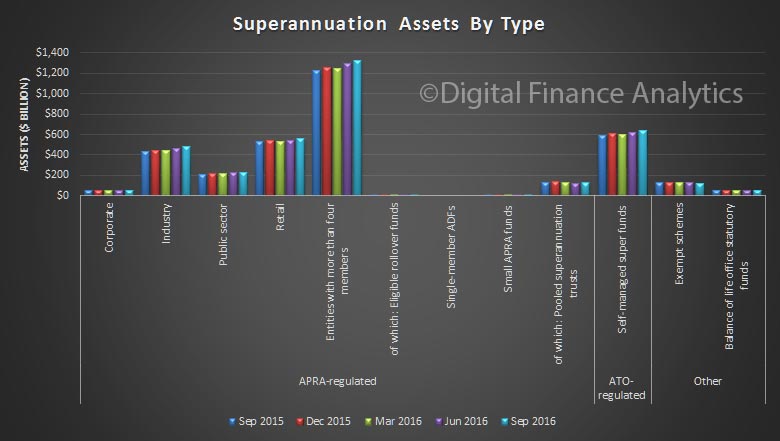 Self managed superannuation balances reached $635.9 billion, up +8.0% in the past year.
Self managed superannuation balances reached $635.9 billion, up +8.0% in the past year.
Total assets in MySuper products totalled $492.2 billion at the end of the September 2016 quarter. Over the 12 months from September 2015 there was a 13.6 per cent increase in total assets in MySuper products, and a 23.7 per cent decrease in total assets in accrued default amounts to $39.6 billion.
There were $23.2 billion of contributions in the September 2016 quarter, down 4.7 per cent from the September 2015 quarter ($24.4 billion). Total contributions for the year ending September 2016 were $103.1 billion. Outward benefit transfers exceeded inward benefit transfers by $1.0 billion in the September 2016 quarter.
There were $17.0 billion in total benefit payments in the September 2016 quarter, an increase of 6.6 per cent from the September 2015 quarter ($15.9 billion). Total benefit payments for the year ending September 2016 were $65.7 billion. Lump sum benefit payments ($8.3 billion) were 49.1 per cent and pension benefit payments ($8.6 billion) were 50.9 per cent of total benefit payments in the September 2016 quarter. For the year ending September 2016, lump sum benefit payments ($33.0 billion) were 50.2 per cent and pension payments ($32.7 billion) were 49.8 per cent of total benefit payments.
Net contribution flows (contributions plus net benefit transfers less benefit payments) totalled $5.3 billion in the September 2016 quarter, a decrease of 30.4 per cent from the September 2015 quarter ($7.6 billion). Net contribution flows for the year ending September 2016 were $31.7 billion.
ASIC Cancels the Registration of 133 SMSF Auditors
ASIC has cancelled the registration of 133 approved self-managed superannuation fund (SMSF) auditors who did not lodge their annual statements.
On 28 July 2016, ASIC sent a final warning to 185 approved SMSF auditors with outstanding annual statements. ASIC had alerted these auditors on a number of occasions that their registration would be cancelled if their outstanding statements were not lodged with fees paid.
SMSF auditors have had ample time to come to grips with their responsibilities. Auditors who do not ensure that they are aware of and meet their obligations face the risk of losing their registration. An unregistered auditor is not permitted to audit an SMSF. Conducting an audit of an SMSF when not permitted to do so may have further serious consequences for the fund and the auditor.
Approved SMSF auditors can confirm if they have lodged annual statements or update their contact details by accessing their ASIC Connect account.
SMSF trustees and members can check whether their auditor is registered, or whether a person has been disqualified, by searching ASIC’s SMSF Auditor register.
Background
From 1 July 2013, the Superannuation Industry (Supervision) Act 1993 required all auditors of SMSFs to be registered with ASIC. This was to ensure that all SMSF auditors at least meet the base standards of competency and expertise.
ASIC and the ATO work closely together as co-regulators of SMSF auditors. The ATO monitors SMSF auditor conduct and may refer matters to ASIC for possible action such as disqualification or suspension of their registration.
Approved SMSF auditors need to lodge an annual statement with ASIC within 30 days of the annual anniversary of their registration. ASIC sends email notifications on anniversary dates advising that annual statements are ready for completion. If an extension of time to lodge the annual statement is required, a written request to ASIC must be made before the due date. An annual statement is not considered to be lodged until the required lodgement fee has been paid.
ASIC notified 811 approved SMSF auditors that they had not met their annual statement requirement and that ASIC may cancel their registration. This included 95 auditors that had lodged annual statements but had not paid their lodgement fee. 626 auditors subsequently lodged their annual statement or paid outstanding fees.
Changes to approved SMSF auditor contact details, including email and mailing addresses, must be provided to ASIC within 21 days of the change occurring. There is no fee to update these details.
Approved SMSF auditors seeking to cancel their registration voluntarily can do so by completing a cancellation request form, available on ASIC’s website.
SuperConcepts acquires software funds in strategic alliance with Reckon
SuperConcepts has announced the acquisition of Reckon’s Desktop Super platform, which will see the transition of approximately 16,000 SMSF software clients to the SuperConcepts business.
The acquisition continues SuperConcepts’ growth as a provider of SMSF software services to accountants and specialist SMSF advisers, increasing its market share across both administration and software services from 6.8 to 9.7 per cent.
 SuperConcepts and Reckon have also formed a strategic alliance to leverage each other’s expertise and industry relationships to provide customers with a leading SMSF software service.
SuperConcepts and Reckon have also formed a strategic alliance to leverage each other’s expertise and industry relationships to provide customers with a leading SMSF software service.
Natasha Fenech, CEO SuperConcepts said the acquisition and strategic alliance is another step forward ingrowing the SuperConcepts business as a leading end-to-end service provider in the SMSF market.
“Reckon is a highly-regarded provider of accounting software services. We’re excited to form an alliance that will help us to enhance the level of service and technology available to SMSF trustees and their advisers.
“SMSF software continues to be a key part of our strategy and we will continue to invest in the technology as we expand our service to become a market leader in SMSF software solutions and partner of choice forthe SMSF industry,” she said.
In-line with its strategy, SuperConcepts has continued to build scale in the SMSF market as an end-to-end provider of administration, software and education services to SMSF trustees, accountants and financial advisers.
Sam Allert, Managing Director Reckon for Australia and New Zealand said: “Our strategic alliance with SuperConcepts ensures Reckon is providing the best value SMSF software solution to our clients going forward. We’re thrilled to be to working with a leading brand in the SMSF administration market and this is just the start of a powerful partnership.”
Desktop Super customers will not notice any immediate change to the way they access their funds.
About SuperConceptsSuperConcepts is a leading provider of self-managed superannuation fund (SMSF) administration, software and education services to SMSF trustees, accountants and financial advisers, servicing more than 40,000 funds.SuperConcepts comprises a number of sub-brands including AMP SMSF, Ascend, Cavendish, Multiport, Justsuper, SuperConcepts, SuperIQ, superMate, yourSMSF and a part ownership of Class Ltd. Find out more at www.superconcepts.com.au.
About ReckonReckon is an ASX listed and Australian owned company with over 25 years’ experience delivering market leading solutions to accountants and bookkeepers, legal professionals and small to medium sized businesses. Reckon’s software solutions are designed to make accounting faster, easier and more productive. Find out more at www.reckon.com.

